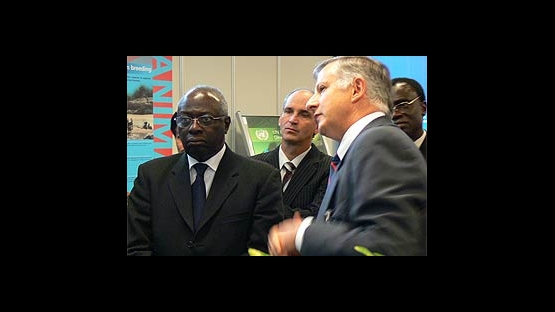Jacques Diouf, Director-General of the Food and Agriculture Organization (FAO), on Tuesday hailed the joint FAO/IAEA programme, Nuclear Techniques in Food and Agriculture, as one of the best examples of inter-agency cooperation in the United Nations family. "We have worked together successfully for more than forty years," he said. "We believe in the peaceful use of nuclear technology as applied to areas such as agriculture, crops, fighting disease, and soil and water management."
Speaking at the Scientific Forum, within the context of the IAEA´s 51st General Conference, Mr. Diouf enumerated some of the most notable and sustainable successes of the cooperation. He described the millions of hectares of higher-yielding and disease resistant crops gained through radiation-induced mutations, the improvement of livestock and agricultural systems through the eradication of insect pests such as the screwworm, the tsetse fly and the fruit fly using sterile insect technique (SIT), and the use of isotopic techniques to enhance water use efficiency and crop productivity.
Engaging with the Forum´s main theme - the global challenges of the next 25 years - Mr. Diouf said that with less than ten years to go until the 2015 deadline for the Millennium Development Goals, the problems facing the world in the areas of food and agriculture remain enormous. "We obviously need to grow more food, and to do so in a sustainable manner and in full respect of plant and animal biodiversity," he said. "There are 854 millions of hungry people presently in a world population of six billion, expected to reach nine billion persons by 2050."
According to Mr. Diouf, the Millennium Development Goals could still be reached: "But only if we redouble our efforts and focus them in locations and on actions where they can make a concrete and significant difference in a relatively short period of time."
Currently, some 70% of the world´s poor live in rural areas that are dependent on agriculture. But many agricultural production systems are fragile; some seriously deplete resources while others are vulnerable to the vagaries of weather and war. Water supplies to meet growing agricultural demands will be a major challenge in the future. Another will be the risk of the spread of diseases originating in animals, such as Avian Influenza. As huge amounts of foodstuffs are moved around the globe, a further challenge for the FAO will be maintaining and guaranteeing the safety of the foods we eat. "So far we have managed to keep a step ahead of emerging health threats. But there is no room for complacency," said Mr. Diouf.
To meet the challenges of the next 25 years, words must be translated into actions. "A challenge can also be seen as an opportunity," Mr. Diouf said. But this requires the political will of national governments to commit adequate funds to revitalize agriculture and rural sectors. At the same time, developed nations must fulfil their pledges to increase development assistance.
For their part, the FAO and the IAEA are committed to continuing their successful relationship to meet the new demands and challenges of our times.
Background:
The first arrangements to establish the Joint FAO/IAEA Division of Atomic Energy in Agriculture were concluded on 1 October 1964. Arrangements were revised in 1997 and signed by the Directors General of FAO and IAEA in December 2001.


